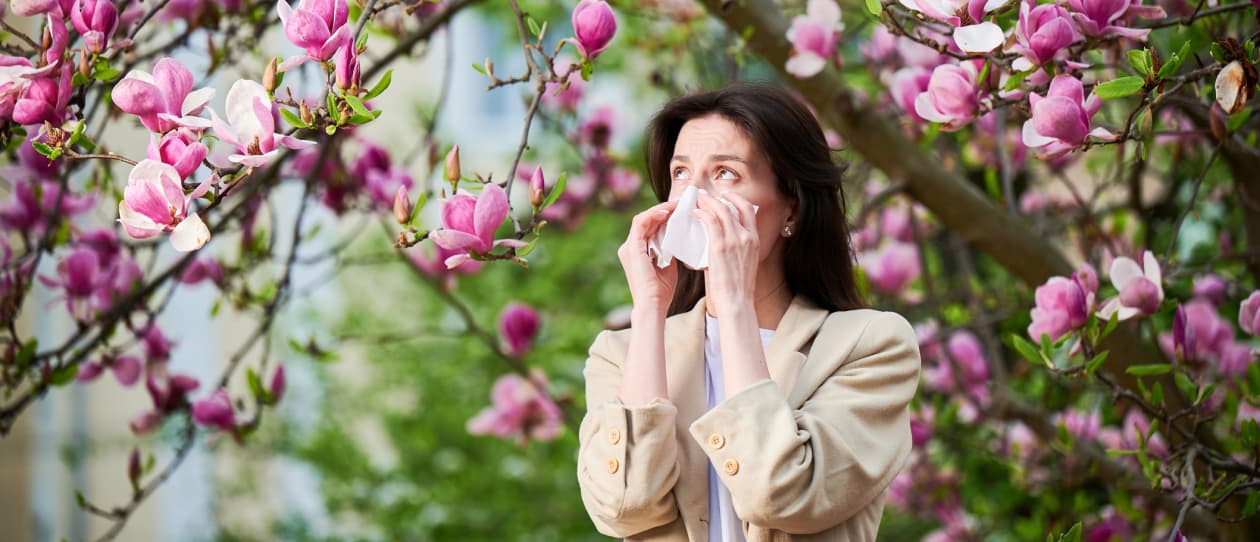
- Health hub/
- Tips & Advice on Cold, Flu & Boosting Immunity/
- How to manage hay fever symptoms naturally: your complete guide to allergy relief


Have you ever found yourself in a relentless cycle of sneezing fits and watery eyes that seemed to come from nowhere? What starts as occasional sniffles can quickly escalate into something that makes you wonder if you've caught a cold. But when symptoms vanish overnight only to return sporadically over the following days, you might be experiencing hay fever rather than a viral infection.
Based on self-reports, almost one in four Australians (23.9% of the population) had allergic rhinitis according to the Australian Bureau of Statistics National Health Survey 2023, as reported by ASCIA. This represents a significant increase from 15% in 2008. What's even more concerning is that climate change has led to unpredictable pollen seasons, fueling a rise in hay fever across the country.
If you're among the millions of Australians struggling with hay fever symptoms, you're probably searching for relief that doesn't leave you drowsy or dependent on daily medication. This comprehensive guide explores evidence-based natural approaches to managing hay fever, from understanding your triggers to implementing practical daily strategies that can help you reclaim your quality of life.
What is the difference between hay fever and a common cold?
Hay fever, also known as allergic rhinitis, is an allergic reaction to airborne particles like pollen, dust mites, or pet dander. When your immune system overreacts to these normally harmless substances, it triggers the classic hay fever symptoms we're all familiar with.
The confusion between hay fever and viral infections is incredibly common. Both conditions can cause sneezing, runny nose, and general discomfort. However, understanding the key differences can help you choose the right treatment approach. Hay fever symptoms often appear suddenly and include sneezing, runny nose, and itchy eyes that persist for weeks during allergy season, while cold symptoms develop gradually and typically resolve within 7-10 days. Here's how to tell them apart:
| Hay Fever (Allergic Rhinitis): | Common Cold: |
| Sudden onset when exposed to triggers | Gradual development over 1-2 days |
| Symptoms persist for weeks or months | Symptoms typically resolve within 7-10 days |
| Itchy, watery eyes are common | Eyes rarely affected |
| Clear, watery nasal discharge | Nasal discharge may become thick and coloured |
| No fever | May include low-grade fever |
| Symptoms often worse at certain times of day or year in specific locations | Symptoms consistent regardless of location |
If you experience persistent symptoms lasting more than two weeks, especially with itchy eyes and clear nasal discharge, you're likely dealing with hay fever rather than a viral infection.
Why are allergies getting worse?
Australian researchers have uncovered compelling evidence that climate change is dramatically altering our allergy landscape. A University of Queensland study has revealed Australian capital cities are experiencing longer pollen seasons due to climate change.What this means for allergy sufferers
These longer pollen seasons mean Australians are experiencing extended periods of exposure to allergens, potentially leading to more severe symptoms and longer treatment periods. Understanding these patterns helps explain why your hay fever might seem worse than it was years ago—it's not just your imagination.Natural ways to reduce hay fever symptoms
While antihistamines and nasal sprays certainly have their place, many Australians are seeking natural alternatives that work with their body's systems rather than simply masking symptoms. Research supports several evidence-based approaches that can provide genuine relief.Nutritional support for allergy relief
Vitamin C
Vitamin C may play a crucial role in supporting your immune system during hay fever season. A well-functioning immune system can help better regulate its response to allergens, potentially reducing the severity of symptoms. Studies show that adequate vitamin C levels help maintain healthy immune function, which is particularly important when your body is dealing with seasonal challenges.
For optimal immune support, consider taking 1000-2000mg daily in divided doses, as vitamin C is water-soluble and your body doesn't store it. This helps maintain consistent levels throughout the day. Food sources rich in vitamin C include oranges, kiwi fruit, red capsicums, strawberries, broccoli, and leafy greens. Consuming these foods regularly throughout allergy season can help maintain steady vitamin C levels and support your overall immune health.
Quercetin
Quercetin, a powerful flavonoid found in apples, onions, and citrus fruits, has garnered significant attention for its natural antihistamine properties. The compound works by preventing the release of histamine and other inflammatory compounds from mast cells, the immune cells responsible for triggering allergic reactions. While quercetin can be sourced through eating a healthy, balanced diet, supplementation may provide more concentrated amounts.
For best absorption, quercetin should be taken with vitamin C, as vitamin C acts as a carrier, enhancing absorption through the gastrointestinal tract, helping it enter the bloodstream faster and stay active for longer periods.
Hydration
Drinking plenty of water helps flush allergens from your system and thins mucus secretions, making it easier for your body to clear irritants from nasal passages. Herbal teas like chamomile or green tea can provide a soothing alternative to plain water while contributing to your daily fluid intake, and the warm steam may help ease nasal congestion.
Herbal remedies with traditional use
Horseradish and Garlic
Traditional Western herbal medicine has long recognised the powerful combination of horseradish and garlic for respiratory support. Horseradish helps clear nasal congestion and sinuses, while garlic provides immune system support with its natural antibacterial properties. This traditional combination is found in Blackmores Horseradish Garlic + C, which combines these herbs with vitamin C for comprehensive support. The formula is traditionally used to relieve symptoms of mild upper respiratory tract infections that may be associated with hay fever, while the added vitamin C supports immune system health. Always read the label and follow directions for use.
Stinging Nettle
Despite its intimidating name, stinging nettle (Urtica dioica) has been traditionally used in Western herbal medicine. This common herb is recognised for its natural anti-inflammatory and antihistamine properties, which may help provide relief from hay fever symptoms. Stinging nettle works by potentially reducing the body's inflammatory response to allergens. The freeze-drying process helps preserve the herb's active compounds, making it a convenient option for those seeking natural allergy support.
Lifestyle strategies
Sleep quality and immune response
Quality sleep plays a crucial role in immune system regulation. Poor sleep can increase inflammation and make allergic reactions more severe. Aim for 7-9 hours of quality sleep each night, and consider these sleep hygiene tips during allergy season:
- Keep windows closed during high pollen periods
- Use air purifiers in bedrooms
- Shower before bed to remove pollen from hair and skin
- Wash bedding in hot water weekly
Stress management and cortisol balance
Chronic stress elevates cortisol levels—your body's primary stress hormone—which can worsen allergic reactions and increase inflammation. When cortisol remains elevated for extended periods, it can cause disruption to your immune system's balance and make you more sensitive to allergens. Regular stress management practices like meditation, gentle yoga, or deep breathing exercises can help modulate your immune response and reduce allergy severity.
The science behind changing pollen patterns
In Australia, we've seen an increase in the duration of the pollen season, with the seasons lasting longer into summer and autumn. This trend reflects global patterns where the annual average number of weeks with pollen concentrations higher than zero increased over time.
Several factors contribute to these changes:
Temperature effects: Daily maximum temperature had positive associations with daily pollen concentrations, meaning warmer days typically bring higher pollen levels.
Rainfall patterns: Daily rainfall and humidity were negatively associated with pollen levels, but changes in precipitation patterns affect seasonal pollen production.
Regional variations: The research reveals significant differences across Australia, with longer, lower intensity seasons in northern latitudes, and shorter yet more intense seasons in southern latitudes.
Using pollen count tools for better management
One of the most practical strategies for managing hay fever is staying informed about daily pollen levels. Modern pollen forecasting allows you to plan your day around allergen exposure, potentially preventing symptoms before they start.
Daily planning strategies:
- Check pollen forecasts the night before to plan the next day
- Schedule outdoor exercise for early morning or evening when pollen counts are typically lower
- Plan indoor activities during peak pollen periods (usually mid-morning to early afternoon)
Reliable Australian pollen resources
The University of Melbourne's pollen forecast website provides accurate, daily pollen counts and forecasts for major Australian cities. This resource includes:
- Current pollen levels
- 7-day forecasts
- Regional variations
- Seasonal calendars showing peak times for different allergens
Making the most of low pollen days
When forecasts predict low pollen levels, take advantage by:
- Airing out your home and changing bedding
- Completing outdoor chores and exercise
- Opening windows for natural ventilation
- Planning outdoor social activities
When high pollen counts strike: your action plan
High pollen days don't have to derail your life. With proper preparation and strategic planning, you can minimise exposure and maintain your daily routine.Indoor air quality management
Air purification: HEPA filter air purifiers can remove up to 99.97% of airborne particles, including pollen. Place units in bedrooms and main living areas for maximum benefit.
Window and ventilation management: Keep windows closed during high pollen periods, particularly between 5am and 10am when many plants release pollen. Use air conditioning with clean filters instead of natural ventilation.
HVAC system maintenance: Replace air conditioning filters monthly during pollen season with high-efficiency filters rated MERV 11 or higher.
Personal protection strategies
Clothing and personal care:
- Wear wraparound sunglasses to protect eyes from airborne pollen
- Choose tight-weave fabrics that don't trap pollen as easily
- Shower and wash hair before bed to remove accumulated pollen
- Change clothes when coming indoors from high pollen environments
Nasal irrigation: Saline nasal rinses help flush pollen and irritants from nasal passages. Use sterile or previously boiled water with appropriate saline solutions for safe and effective relief.
Timing your day around pollen
Morning strategies: Pollen levels are often highest in early morning as flowers open and release pollen. If possible, delay outdoor activities until after 10am.
Exercise timing: Schedule outdoor exercise for early evening or after rain when pollen levels are lower. Indoor alternatives during high pollen days include gym workouts, yoga, or home exercise routines.
Gardening and yard work: When garden maintenance is necessary, wear a dust mask and consider delegating high-pollen tasks to family members without allergies. Complete outdoor work quickly and shower immediately afterward.
Building long-term allergy resilience
Managing hay fever effectively requires more than addressing acute symptoms—it involves building your body's resilience to allergens over time.Immune system support through nutrition
A diet rich in anti-inflammatory foods can help modulate your immune response and reduce allergic reactivity. Focus on:
Omega-3 rich foods: Fatty fish like salmon, sardines, and mackerel contain omega-3 fatty acids that help reduce inflammation. Plant sources include walnuts, flaxseeds, and chia seeds.
Colourful fruits and vegetables: The variety of antioxidants in deeply coloured produce helps combat the oxidative stress associated with allergic reactions.
Probiotic foods: Fermented foods like yoghurt, kefir, and sauerkraut support gut health, which plays a crucial role in immune system regulation.
Seasonal preparation strategies
Pre-seasonal support: Begin implementing natural support strategies 4-6 weeks before your typical allergy season starts. This allows your body time to build up protective compounds and strengthen immune responses.
Environmental modifications: Make gradual changes to your living environment that reduce overall allergen load, such as replacing carpets with hard flooring, using allergen-proof bedding covers, and maintaining low indoor humidity levels.
When to consider professional allergy testing
While natural management strategies are effective for many people, comprehensive allergy testing can provide valuable insights into your specific triggers. Consider professional testing if:
- Your symptoms are severe or interfere significantly with daily life
- You experience year-round symptoms suggesting multiple triggers
- Natural approaches haven't provided adequate relief after consistent use
- You're considering immunotherapy (allergy shots) as a treatment option
Red flags: when to seek professional help
While hay fever is generally manageable with natural approaches, certain symptoms require immediate medical attention.
Seek urgent medical care if you experience:
- Difficulty breathing or wheezing
- Severe swelling of face, lips, or throat
- Rapid pulse or dizziness
- Severe, sudden onset of symptoms
Consult your healthcare provider if:
- Symptoms persist despite consistent natural management
- You develop frequent sinus infections
- Sleep is significantly disrupted for more than a few days
- Symptoms worsen or change pattern unexpectedly
Important safety considerations:
- Natural remedies can interact with medications—always inform your healthcare provider about supplements you're taking
- Some herbs may not be suitable during pregnancy or breastfeeding
- Gradual exposure techniques should only be attempted under professional supervision
Remember, natural approaches work best as part of a comprehensive health strategy that includes appropriate medical care when needed.
Your path to better allergy management
Managing hay fever naturally isn't about choosing between conventional and alternative approaches—it's about finding the right combination of strategies that work for your unique situation and lifestyle. The evidence is clear: natural approaches like vitamin C, quercetin, traditional herbal combinations, and smart environmental management can provide significant relief for many allergy sufferers. Combined with modern tools like pollen forecasting and strategic daily planning, these approaches offer a sustainable path to better quality of life during allergy season.
Your next steps:
- Start tracking local pollen counts and your symptom patterns
- Implement dietary changes gradually, focusing on anti-inflammatory foods
- Consider targeted natural supplements like vitamin C and quercetin
- Create an action plan for high pollen days
- Build relationships with healthcare providers who understand integrative approaches
Remember, the goal isn't to eliminate all allergy symptoms overnight but to reduce their impact on your daily life while supporting your body's natural resilience.
Whether you're dealing with the increasingly challenging pollen seasons that climate change is bringing to Australia or simply seeking alternatives to conventional medications, natural hay fever management offers hope for lasting relief. Start with small, manageable changes and build your personalised approach over time.




